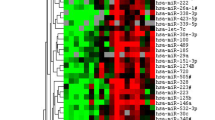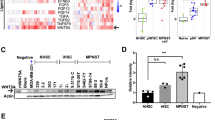Abstract
Neurofibromas represent one of the hallmarks of neurofibromatosis 1 (NF1) patients. Tumor progression of neurofibromas to malignant peripheral nerve sheath tumors (MPNST) is a frequent and life threatening complication. To learn more about processes involved in malignant transformation, we evaluated differential gene expression in plexiform neurofibroma and MPNST from the same NF1 patient. Suppression subtractive hybridization (SSH) yielded 133 differentially expressed genes confirmed by reverse Northern blotting. Virtual Northern blots were employed to validate 23 genes. To independently verify differential expression, immunohistochemical analyses with antibodies to matrix metalloproteinase 13 (MMP13), platelet-derived growth factor receptor alpha (PDGFRA) and fibronectin (FN1) were performed on 9 dermal and 9 plexiform neurofibromas and 16 MPNST from 19 NF1 patients. All three proteins proved to be up-regulated in MPNST. MMP13 expression was observed in 44% of MPNST but was absent in neurofibromas. PDGFRA was expressed in all tumors, but the number of cells expressing it was below 30% in neurofibromas and over 50% in MPNST. Likewise, FN1 was expressed in all tumors, but less than 30% of the cells in neurofibromas and more than 70% of the cells in MPNST exhibited antibody binding. Our data point to several genes not previously recognized to be differentially expressed, and provide a framework for future studies on progression-associated gene expression in low- and high-grade nerve sheath tumors.



Similar content being viewed by others
References
Armstrong PB, Armstrong MT (2000) Intercellular invasion and the organizational stability of tissues: a role for fibronectin. Biochim Biophys Acta 1470:9–20
Badache A, De Vries GH (1998) Neurofibrosarcoma-derived Schwann cells overexpress platelet-derived growth factor (PDGF) receptors and are induced to proliferate by PDGF BB. J Cell Physiol 177:334–342
Basu TN, Gutmann DH, Fletcher JA, Glover TW, Collins FS, Downward J (1992) Aberrant regulation of ras proteins in malignant tumour cells from type 1 neurofibromatosis patients. Nature 356:713–715
Bollag G, McCormick F (1991) Differential regulation of ras GAP and neurofibromatosis gene product activities. Nature 351:576–579
Cao R, Brakenhielm E, Li X, Pietras K, Widenfalk J, Ostman A, Eriksson U, Cao Y (2002) Angiogenesis stimulated by PDGF-CC, a novel member in the PDGF family, involves activation of PDGFR-alphaalpha and -alphabeta receptors. FASEB J 16:1575–1583
Dameron KM, Volpert OV, Tainsky MA, Bouck N (1994) Control of angiogenesis in fibroblasts by p53 regulation of thrombospondin-1. Science 265:1582–1584
Diatchenko L, Lau YF, Campbell AP, Chenchik A, Moqadam F, Huang B, Lukyanov S, Lukyanov K, Gurskaya N, Sverdlov ED, Siebert PD (1996) Suppression subtractive hybridization: a method for generating differentially regulated or tissue-specific cDNA probes and libraries. Proc Natl Acad Sci USA 93:6025–6030
Eisenbarth I, Beyer K, Krone W, Assum G (2000) Toward a survey of somatic mutation of the NF1 gene in benign neurofibromas of patients with neurofibromatosis type 1. Am J Hum Genet 66:393–401
Evans DG, Baser ME, McGaughran J, Sharif S, Howard E, Moran A (2002) Malignant peripheral nerve sheath tumours in neurofibromatosis 1. J Med Genet 39:311–314
Finch RA, Donoviel DB, Potter D, Shi M, Fan A, Freed DD, Wang CY, Zambrowicz BP, Ramirez-Solis R, Sands AT, Zhang N (2002) mdmx is a negative regulator of p53 activity in vivo. Cancer Res 62:3221–3225
Franz O, Bruchhaus II, Roeder T (1999) Verification of differential gene transcription using virtual Northern blotting. Nucleic Acids Res 27:e3
Haupt Y, Maya R, Kazaz A, Oren M (1997) Mdm2 promotes the rapid degradation of p53. Nature 387:296–299
Hermanson M, Funa K, Koopmann J, Maintz D, Waha A, Westermark B, Heldin C-H, Wiestler OD, Louis DN, Deimling A von, Nister M (1996) Association of loss of heterozygosity on chromosome 17p with high platelet-derived growth factor alpha receptor expression in human malignant gliomas. Cancer Res 56:164–171
Huson SM (1994) Neurofibromatosis 1: a clinical and genetic overview. In: Huson SM, Hughes RAC (eds) The neurofibromatoses. Chapman and Hall Medical, London, pp 160–203
Ioachim E, Charchanti A, Briasoulis E, Karavasilis V, Tsanou H, Arvanitis DL, Agnantis NJ, Pavlidis N (2002) Immunohistochemical expression of extracellular matrix components tenascin, fibronectin, collagen type IV and laminin in breast cancer: their prognostic value and role in tumour invasion and progression. Eur J Cancer 38:2362–2370
Jolly C, Morimoto RI (2000) Role of the heat shock response and molecular chaperones in oncogenesis and cell death. J Natl Cancer Inst 92:1564–1572
Kluwe L, Friedrich R, Mautner V (1999) Loss of NF1 allele in schwann cells but not in fibroblasts derived from a NF-1 associated neurofibroma. Genes Chromosomes Cancer 24:283–285
Knauper V, Cowell S, Smith B, Lopez-Otin C, O’Shea M, Morris H, Zardi L, Murphy G (1997) The role of the C-terminal domain of human collagenase-3 (MMP-13) in the activation of procollagenase-3, substrate specificity, and tissue inhibitor of metalloproteinase interaction. J Biol Chem 272:7608–7616
Kourea HP, Orlow I, Scheithauer BW, Cordon-Cardo C, Woodruff JM (1999) Deletions of the INK4A gene occur in malignant peripheral nerve sheath tumors but not in neurofibromas. Am J Pathol 155:1855–1860
Legius E, Marchuk DA, Collins FS, Glover TW (1993) Somatic deletion of the neurofibromatosis type 1 gene in a neurofibrosarcoma supports a tumour suppressor gene hypothesis. Nat Genet 3:122–126
MacDonald TJ, Brown KM, LaFleur B, Peterson K, Lawlor C, Chen Y, Packer RJ, Cogen P, Stephan DA (2001) Expression profiling of medulloblastoma: PDGFRA and the RAS/MAPK pathway as therapeutic targets for metastatic disease. Nat Genet 29:143–152
McCormick F (1993) Signal transduction. How receptors turn Ras on. Nature 363:15–16
Menon AG, Anderson KM, Riccardi VM, Chung RY, Whaley JM, Yandell DW, Farmer GE, Freiman RN, Lee JK, Li FP, Barker DF, Ledbetter DH, Kleider A, Martuza RL, Gusella JF, Seizinger BR (1990) Chromosome 17p deletions and p53 gene mutations associated with the formation of malignant neurofibrosarcomas in Recklinghausen neurofibromatosis. Proc Natl Acad Sci USA 87:5435–5439
Nielsen GP, Stemmer-Rachamimov AO, Ino Y, Moller MB, Rosenberg AE, Louis DN (1999) Malignant transformation of neurofibromas in neurofibromatosis 1 is associated with CDKN2A/p16 inactivation. Am J Pathol 155:1879–1884
NIH Consensus Development Conference Statement (1988) Neurofibromatosis. Arch Neurol 45:575–578
Peek R, Kammerer RA, Frank S, Otte-Holler I, Westphal JR (2002) The angiopoietin-like factor cornea-derived transcript 6 is a putative morphogen for human cornea. J Biol Chem 277:686–693
Peltonen J, Jaakkola S, Lebwohl M, Renvall S, Risteli L, Virtanen I, Uitto J (1988) Cellular differentiation and expression of matrix genes in type 1 neurofibromatosis. Lab Invest 59:760–771
Penta JS, Johnson FM, Wachsman JT, Copeland WC (2001) Mitochondrial DNA in human malignancy. Mutat Res 488:119–133
Peters N, Waha A, Wellenreuther R, Friedrich RE, Mautner VF, Hoffmeyer S, Schramm J, Wiestler OD, Deimling A von (1999) Quantitative analysis of NF1 gene transcripts in sporadic gliomas, sporadic meningiomas and Neurofibromatosis type 1 associated plexiform neurofibromas. Acta Neuropathol (Berl) 58:547–551
Rao UN, Sonmez-Alpan E, Michalopoulos GK (1997) Hepatocyte growth factor and c-MET in benign and malignant peripheral nerve sheath tumors. Hum Pathol 28:1066–1070
Rasmussen SA, Yang Q, Friedman JM (2001) Mortality in neurofibromatosis 1: an analysis using U.S. death certificates. Am J Hum Genet 68:1110–1118
Sawada S, Florell S, Purandara SM, Ota M, Stephens K, Viskochil D (1996) Identification of NF1 mutations in both alleles of a dermal neurofibroma. Nat Genet 14:119–112
Serra E, Rosenbaum T, Winner U, Aledo R, Ars E, Estivill X, Lenard HG, Lazaro C (2000) Schwann cells harbor the somatic NF1 mutation in neurofibromas: evidence of two different Schwann cell subpopulations. Hum Mol Genet 9:3055–3064
Serra E, Ars E, Ravella A, Sanchez A, Puig S, Rosenbaum T, Estivill X, Lazaro C (2001) Somatic NF1 mutational spectrum in benign neurofibromas: mRNA splice defects are common among point mutations. Hum Genet 108:416–429
Side L, Taylor B, Cayouette M, Conner E, Thompson P, Luce M, Shannon K (1997) Homozygous inactivation of the NF1 gene in bone marrow cells from children with neurofibromatosis type 1 and malignant myeloid disorders. N Engl J Med 336:1713–1720
Stein OD von, Thies WG, Hofmann M (1997) A high throughput screening for rarely transcribed differentially expressed genes. Nucleic Acids Res 25:2598–2602
Watanabe T, Oda Y, Tamiya S, Masuda K, Tsuneyoshi M (2001) Malignant peripheral nerve sheath tumour arising within neurofibroma. An immunohistochemical analysis in the comparison between benign and malignant components. J Clin Pathol 54:631–636
Zhu Y, Ghosh P, Charnay P, Burns DK, Parada LF (2002) Neurofibromas in NF1: Schwann cell origin and role of tumor environment. Science 296:920–922
Zoller ME, Rembeck B, Oden A, Samuelsson M, Angervall L (1997) Malignant and benign tumors in patients with neurofibromatosis type 1 in a defined Swedish population. Cancer 79:2125–2131
Acknowledgements
We thank Kathrein Stichling for her technical assistance and Dr. Michael Baier and Prof. Reinhold Schäfer for helpful discussions. This work was supported by the Deutsche Krebshilfe.
Author information
Authors and Affiliations
Corresponding author
Rights and permissions
About this article
Cite this article
Holtkamp, N., Mautner, VF., Friedrich, R.E. et al. Differentially expressed genes in neurofibromatosis 1-associated neurofibromas and malignant peripheral nerve sheath tumors. Acta Neuropathol 107, 159–168 (2004). https://doi.org/10.1007/s00401-003-0797-8
Received:
Revised:
Accepted:
Published:
Issue Date:
DOI: https://doi.org/10.1007/s00401-003-0797-8




